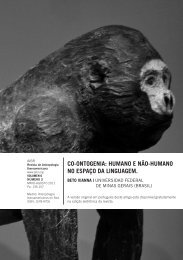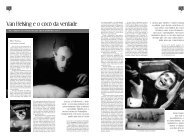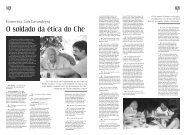Merleau-Ponty, 1964. Eye and mind. - Biolinguagem
Merleau-Ponty, 1964. Eye and mind. - Biolinguagem
Merleau-Ponty, 1964. Eye and mind. - Biolinguagem
- No tags were found...
You also want an ePaper? Increase the reach of your titles
YUMPU automatically turns print PDFs into web optimized ePapers that Google loves.
would vision be without eye movement And how could the movement of the eyes not<br />
blur things if movement were blind If it were only a reflex If it did not have its antennae,<br />
its clairvoyance If vision were not prefigured in it<br />
All my changes of place figure on principle in a corner of my l<strong>and</strong>scape; they are carried<br />
over onto the map of the visible. Everything I see is on principle within my reach, at least<br />
within reach of my sight, <strong>and</strong> is marked upon the map of the "I can." Each of the two<br />
maps is complete. The visible world <strong>and</strong> the world of my motor projects are both total<br />
parts of the same Being.<br />
This extraordinary overlapping, which we never give enough thought to, forbids us to<br />
conceive of vision as an operation of thought that would set up before the <strong>mind</strong> a picture<br />
or a representation of the world, a world of immanence <strong>and</strong> of ideality. Immersed in the<br />
visible by his body, itself visible, the see-er does not appropriate what he sees; he merely<br />
approaches it by looking, he opens onto the world. And for its part, that world of which he<br />
is a part is not in itself, or matter. My movement is not a decision made by the <strong>mind</strong>, an<br />
absolute doing which would decree, from the depths of a subjective retreat, some change<br />
of place miraculously executed in extended space. It is the natural sequel to, <strong>and</strong><br />
maturation of, vision. I say of a thing that it is moved; but my body moves itself; my<br />
movement is self-moved. It is not ignorance of self, blind to itself; it radiates from a self….<br />
The enigma derives from the fact that my body simultaneously sees <strong>and</strong> is seen. That<br />
which looks at all things can also look at itself <strong>and</strong> recognize, in what it sees, the "other<br />
side" of its power of looking. It sees itself seeing; it touches itself touching; it is visible <strong>and</strong><br />
sensitive for itself. It is a self, not by transparency, like thought, which never thinks<br />
anything except by assimilating it, constituting it, transforming it into thought—but a self<br />
by confusion, narcissism, inherence of the see-er in the seen, the toucher in the touched,<br />
the feeler in the felt—a self, then, that is caught up in things, having a front <strong>and</strong> a back, a<br />
past <strong>and</strong> a future….<br />
This initial paradox cannot but produce others. Visible <strong>and</strong> mobile, my body is a thing<br />
among things; it is one of them. It is caught in the fabric of the world, <strong>and</strong> its cohesion is<br />
that of a thing. But because it moves itself <strong>and</strong> sees, it holds things in a circle around<br />
itself. 3 Things are an annex or prolongation of itself; they are incrusted in its flesh, they<br />
are part of its full definition; the world is made of the very stuff of the body. These<br />
reversals, these antinomies, 4 are different ways of saying that vision is caught or comes<br />
to be in things—in that place where something visible undertakes to see, becomes visible<br />
to itself <strong>and</strong> in the sight of all things, in that place where there persists, like the original<br />
solution still present within crystal, the undividedness of the sensing <strong>and</strong> the sensed.<br />
This interiority no more precedes the material arrangement of the human body than it<br />
results from it. What if our eyes were made in such a way as to prevent our seeing any<br />
part of our body, or some diabolical contraption were to let us move our h<strong>and</strong>s over<br />
things, while preventing us from touching our own body Or what if, like certain animals,<br />
we had lateral eyes with no cross-blending of visual fields Such a body would not reflect<br />
itself; it would be an almost adamantine body, not really flesh, not really the body of a<br />
human being. There would be no humanity.<br />
But humanity is not produced as the effect of our articulations or by the way our eyes are<br />
implanted in us (still less by the existence of mirrors, though they alone can make our<br />
entire bodies visible to us). These contingencies <strong>and</strong> others like them, without which<br />
mankind would not exist, do not by simple summation bring it about that there is a single<br />
man. The body's animation is not the assemblage or juxtaposition of its parts. Nor is it a<br />
question of a <strong>mind</strong> or spirit coming down from somewhere else into an automation—<br />
3









